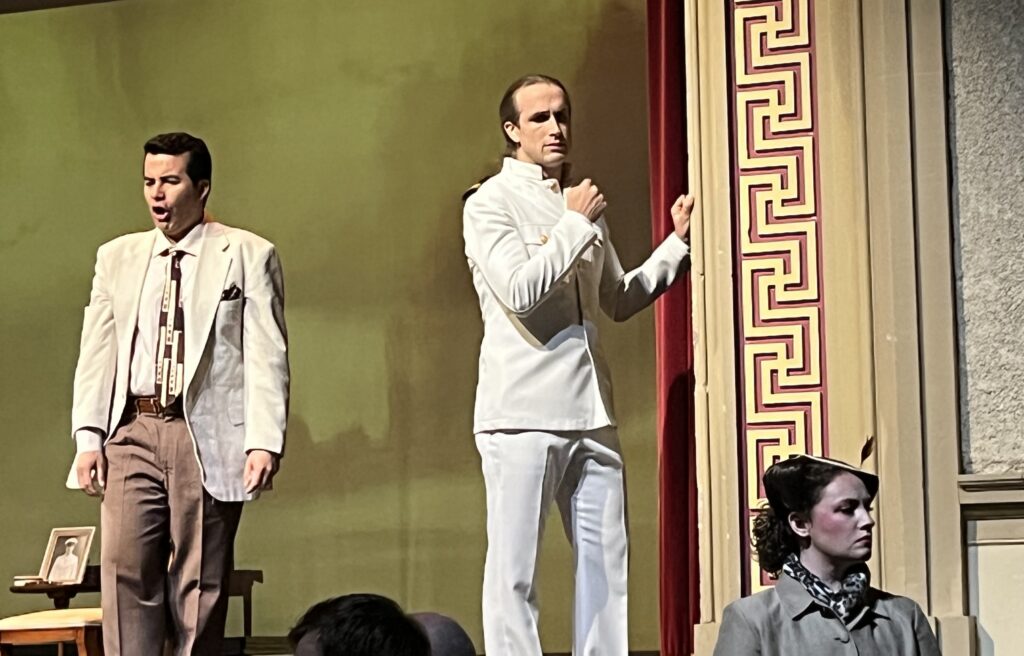Minimalism in the Commonwealth of Virginia — an iconic opera in rarefied format achieved a powerful presence.
Maestro Jorge Parodi’s orchestra of single winds, two horns, strings 3,2,1,2,1, piano, timpani and percussion somehow created many, even most of Puccini’s Butterfly colors that have become an indelible part of our operatic conscious. The score reduction is credited to Osamu Sasaki, emanating from Japan.
Stage director Isabel Milenski had but two armless chairs, a smoking stand, and one small, black platform (covered by a white cloth to create a bed for the Act I somewhat graphic seduction). Williamsburg Opera producer Naama Zahavi-Ely provided a sizable backdrop projection screen, her own created supertitles floating at the top. The greater part of the screen was covered with changing, abstract shapes that echoed the pale colors of Japanese watercolors (further intelligence revealed that the photo images were transformations of reflections of red potato peel in water by Brooklyn based visual artist Roxane Revon).
There were few hand props and little set decoration. In Act I Pinkerton brought his whiskey case and Butterfly brought a small box with her father’s hara-kiri knife. In Act II only a photo of Pinkerton stood atop the smoking stand, in Act III only a black and white cloth doll that became a puppet in Butterfly’s “Tu, tu, tu.” The plucking of cherry blossoms and the opening and closing of shoji (sliding panels) between Acts II and III were mimed.
Conductor Parodi imposed a powerful, unflagging Puccinian musical presence that was spellbinding. There is no pit in Williamsburg’s 400 seat Kimball Theater, thus the individual players seated on the auditorium floor became very much a part of the show — the wind players were highly exposed soloists, as indeed were all the players. Notable was the impeccable tone placing of the horns and the thundering of the tympani.

Director Milenski moved her actors with equal aplomb. Butterfly mounted the platform upstage center for her suicide with all the flourish of a Tosca leap, and dramatically slit her throat in proper Japanese fashion. Puccini’s masterful second act unfolded with unerring pacing, amplifying the act’s cruel precision. The first act revealed traces of updating, Goro in a purple suit, Pinkerton hair in a post modern ponytail, though Butterfly’s family were in kimonos.
The Williamsburg minimalism exposed the grimness of the David Belasco play on which Puccini’s opera is based, its abject grittiness. The production assumed the directness of a documentary, more than it created an emotional world where brutality is veiled by color and sound. Shocking more than moving, the production revealed Puccini’s verismo reaching toward Grand Guignol (the horror theater of his time). It was a riveting theatrical experience.
The production was brought vibrantly alive by its cast of six principals (plus a Kate Pinkerton; the Bonze doubled Yamadori; Sharpless read the marriage vows!). Japanese soprano Miho Sakoda (lead photo, with Pinkerton) well expressed Butterfly’s vulnerability, and her strength, projecting unwavering belief in Pinkerton’s return, and steely resolve to kill herself. Mme. Sakoda is a full lyric soprano of beautiful voice with the ample technique needed to see her through the Herculean demands of the role.
Suzuki was sung by Japanese/American Sophia Maekawa, a young mezzo soprano who is a participant in Lyric Opera of Chicago’s young artist program, soon to make her Wolf Trap debut as Cherubino. Of remarkably smooth voice she pantomimed the opening and closing of the shoji with an elegance that bespoke the tragic delicacy of the Butterfly situation, unleashing her Act III frustration in powerful voice.
Pinkerton was sung by American tenor Ganson Salmon. Mr. Salmon is a light lyric tenor whose Pinkerton was vocally plausible in this small theater, whose presence well portrayed the honest innocence of the young lieutenant, his blatant naivety and his emotional immaturity — he was, finally, a Pinkerton you could forgive. Sharpless was sung by Chilean baritone Javier Arrey. Mr. Arrey created an edgy Sharpless who participated in the Butterfly melodrama in pointed voice, commanding the stage as a cold commentator, not as the usual impotent, but musically sympathetic, bureaucrat.

Japanese character tenor Taka Komagata was an impeccable, strangely lovable Goro, as was the Bonze of Korean baritone Suchan Kim, rendered in powerful voice. Mezzo soprano Abigail Lysinger, a masters degree student at the University of Houston, made a big impression as a formidable Kate Pinkerton.
Butterfly’s family was performed by soprano Mizuho Takeshita, mezzo soprano Mika Urano, soprano Katherine Thorpe and soprano Sophie Morris-Suzuki. The Butterfly entrance was rendered full voice by these four young singers.
Costume design was by Eric Lamp — of special note was Butterfly’s Act II Asian patterned Western style dress. Christina Schwinn oversaw the lighting.
Michael Milenski
Kimball Theater, Williamsburg, Virginia, May 23, 2025.
Stage director Isabel Milenski is Michael Milenski’s daughter.
Photos courtesy of Eric Lamp.